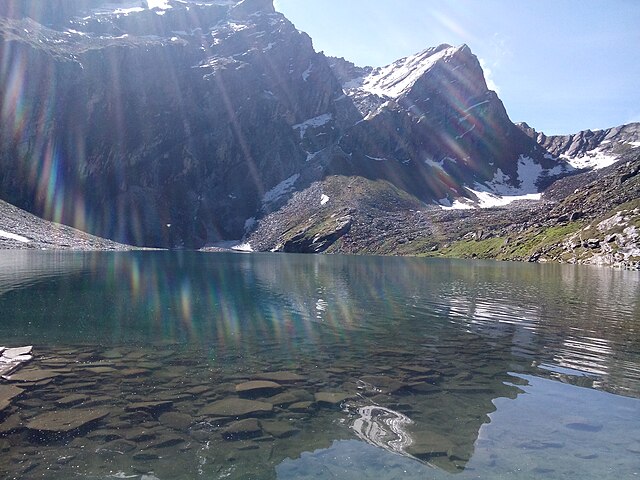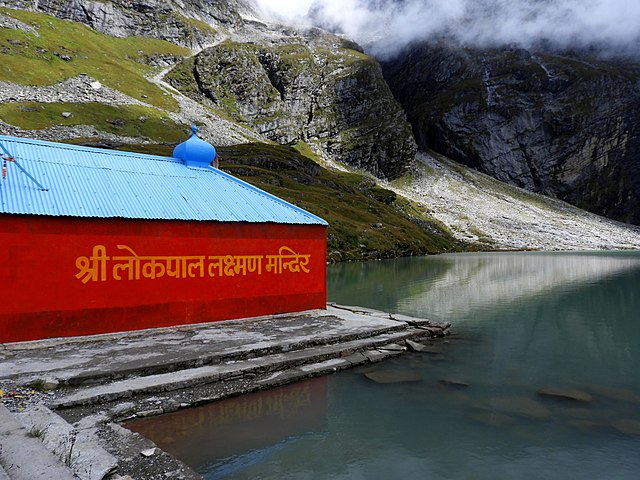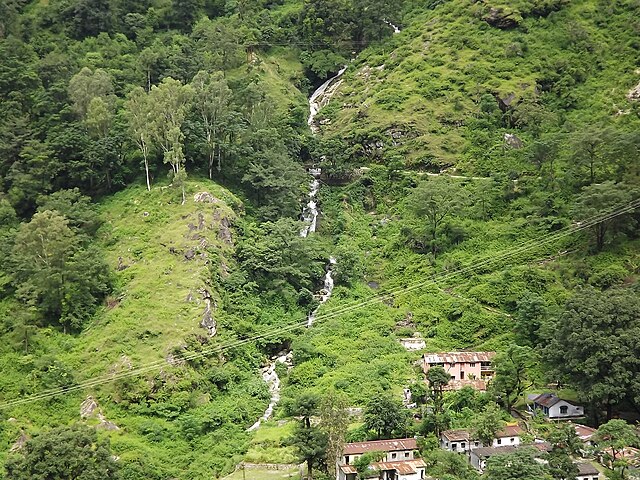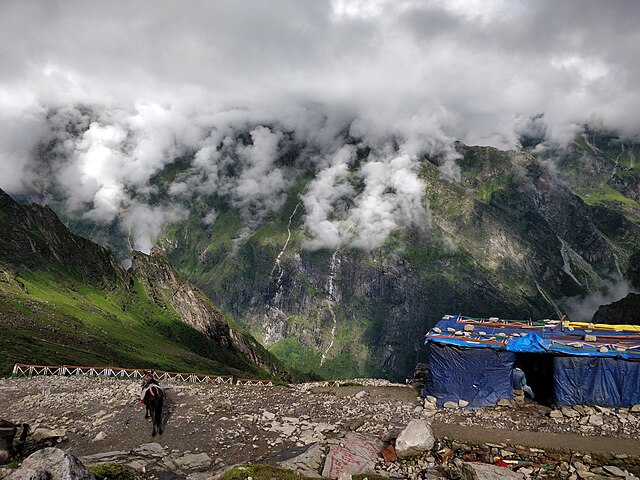Planning a journey to Hemkund Sahib? You’re probably wondering about the weather conditions you’ll encounter at this sacred high-altitude destination. Weather plays a crucial role in determining not just your comfort, but also your safety during this spiritual trek. Let’s dive deep into everything you need to know about Hemkund Sahib’s weather patterns to help you plan the perfect pilgrimage.
Understanding Hemkund Sahib’s Unique Climate
Geographic Location and Altitude Impact
Hemkund Sahib sits majestically at an altitude of 4,329 meters (14,200 feet) above sea level in the Chamoli district of Uttarakhand. This extreme elevation creates a unique microclimate that’s dramatically different from the plains below. Think of it like climbing into nature’s refrigerator – the higher you go, the colder it gets!
The location in the Garhwal Himalayas means Hemkund Sahib experiences what meteorologists call an “alpine climate.” This isn’t your typical mountain weather – it’s more like nature’s mood swings on steroids. One moment you might be basking in warm sunshine, and the next, you could be caught in a sudden snowstorm, even during summer months.
The surrounding peaks, including Hathi Parvat and Saptrishi peaks, create a natural amphitheater that influences local weather patterns. These towering giants act like weather magnets, drawing in moisture-laden clouds and creating their own precipitation systems.
Seasonal Weather Patterns Overview
Hemkund Sahib follows a distinct seasonal pattern that’s quite different from what you might expect. The “seasons” here are more like weather personalities – each with its own characteristics and challenges.
The region experiences essentially two main weather phases: the accessible season (May to October) and the snow-locked period (November to April). During the accessible months, weather can still be unpredictable, with temperatures ranging from pleasantly cool to bone-chillingly cold within hours.
What makes Hemkund Sahib’s weather truly unique is its ability to showcase multiple seasons in a single day. You might start your trek in spring-like conditions, experience summer warmth at midday, encounter autumn chills in the evening, and wake up to winter frost the next morning!
Month-by-Month Weather Breakdown

Pre-Season Conditions (March-April)
March and April are teaser months at Hemkund Sahib. The gurudwara remains closed during this period, but understanding these months helps you appreciate the dramatic transformation that occurs as the season opens.
During March, temperatures at Hemkund Sahib typically hover between -15°C to -5°C (5°F to 23°F). The entire area remains under a thick blanket of snow, sometimes reaching depths of 10-15 feet! Can you imagine walking through snow that’s taller than you? That’s exactly why the trek remains closed.
April brings the first hints of change, with temperatures slowly climbing to -10°C to 0°C (14°F to 32°F). The snow begins its gradual retreat, but the area is still largely inaccessible. This is when the authorities and local communities start preparing for the season opening, often using the weather windows to clear pathways and assess conditions.
Peak Season Weather (May-June)
May marks the grand opening of Hemkund Sahib, and with it comes the most favorable weather conditions of the year. Early May temperatures range from 0°C to 10°C (32°F to 50°F), making it perfect for trekking – if you’re properly prepared!
The beauty of May weather lies in its relative stability. You’re less likely to encounter the dramatic weather swings that characterize later months. Morning temperatures might still dip below freezing, but by afternoon, you could be shedding layers as temperatures climb into comfortable ranges.
June continues this pleasant trend, with temperatures ranging from 5°C to 15°C (41°F to 59°F). This is often considered the sweet spot for visiting Hemkund Sahib. The snow has largely melted from the trekking routes, wildflowers begin their spectacular show, and the famous glacial lake starts to reveal its stunning blue-green waters.
However, don’t let these “comfortable” temperatures fool you. At this altitude, weather can change faster than you can say “Waheguru!” Always be prepared for sudden temperature drops, especially during late afternoons and evenings.
Monsoon Impact (July-August)
July and August bring the monsoon season to Hemkund Sahib, and this is where things get interesting – and challenging. Temperatures during these months range from 8°C to 18°C (46°F to 64°F), which might sound pleasant, but the real story is in the precipitation.
The monsoon doesn’t just bring rain to Hemkund Sahib; it brings a complete weather transformation. Cloud cover becomes almost constant, reducing visibility and creating a mystical, otherworldly atmosphere. The higher altitude means that what falls as rain in the valleys often arrives as snow or sleet at Hemkund Sahib.
Rainfall during these months can be intense and unpredictable. You might experience bright sunshine for hours, only to be caught in a sudden downpour that seems to come from nowhere. The landscape transforms into a lush, green paradise, but trekking conditions become significantly more challenging.
Post-Monsoon Clarity (September-October)
September brings some of the most spectacular weather conditions to Hemkund Sahib. With temperatures ranging from 2°C to 12°C (36°F to 54°F), this month offers crystal-clear skies and stunning mountain views that take your breath away – literally and figuratively!
The post-monsoon period is characterized by exceptional visibility. The rains have washed the air clean, and you can see for miles in every direction. The surrounding peaks appear so close you feel like you could reach out and touch them. This is photography weather at its finest!
October marks the beginning of the end for the trekking season. Temperatures start dropping more significantly, ranging from -5°C to 8°C (23°F to 46°F). Early October can still offer excellent conditions, but as the month progresses, the threat of early snowfall increases dramatically.
Winter Closure Period (November-February)
From November through February, Hemkund Sahib transforms into a winter wonderland that’s both beautiful and completely inaccessible. Temperatures plummet to extreme lows, often reaching -25°C to -15°C (-13°F to 5°F).
During these months, snowfall is heavy and consistent. The entire region becomes locked in winter’s grip, with snow depths that can exceed 20 feet in some areas. The harsh conditions make it impossible for pilgrims to reach the gurudwara, which is why it remains officially closed during this period.
Temperature Variations Throughout the Day

Morning Temperature Ranges
Mornings at Hemkund Sahib are crisp, to put it mildly. Even during the peak summer months of May and June, morning temperatures typically start below freezing. You’ll often wake up to frost on your tent or find ice crystals forming on the lake’s surface.
The early morning hours, typically between 4 AM and 7 AM, represent the coldest part of the day. During May, expect temperatures around -2°C to 2°C (28°F to 36°F). In June, it warms up slightly to 0°C to 5°C (32°F to 41°F), but you’ll still need warm layers.
What’s fascinating about morning weather at Hemkund Sahib is the rapid transformation that occurs with sunrise. As the first rays of sunlight hit the surrounding peaks, you can literally feel the temperature beginning to climb. It’s like watching nature’s thermostat in action!
Afternoon Weather Conditions
Afternoons bring the warmest and most pleasant conditions to Hemkund Sahib. This is when the altitude’s thin air allows the sun’s rays to provide maximum warmth, creating surprisingly comfortable conditions for such a high-altitude location.
During peak season months, afternoon temperatures can reach 15°C to 20°C (59°F to 68°F) in sunny, sheltered areas. You might find yourself shedding layers and even enjoying a comfortable outdoor meal. However, remember that “warm” at 14,200 feet feels different from warm at sea level.
The afternoon hours also bring the highest likelihood of clear skies and excellent visibility. This is prime time for photography, meditation, and simply soaking in the incredible mountain scenery. The contrast between the crystal-clear blue sky and the snow-capped peaks creates views that will remain etched in your memory forever.
Evening and Night Temperature Drops
As evening approaches, temperatures at Hemkund Sahib begin their dramatic descent. The thin atmosphere at this altitude means heat dissipates quickly once the sun starts setting. It’s like someone gradually turning down nature’s thermostat.
Evening temperatures, typically between 6 PM and 9 PM, can drop to 5°C to 10°C (41°F to 50°F) during peak season. By night time, temperatures often fall below freezing again, creating a full circle back to morning conditions.
The rapid temperature change from afternoon to evening can catch unprepared visitors off guard. One minute you’re comfortable in light layers, and the next, you’re reaching for your heaviest jacket. This is why layered clothing isn’t just recommended – it’s essential for comfort and safety.
Precipitation Patterns and Rainfall
Annual Rainfall Statistics
Hemkund Sahib receives most of its annual precipitation during the monsoon months of July and August. The average annual rainfall ranges from 1,200 to 1,800 millimeters (47 to 71 inches), with the majority falling during the monsoon season.
What makes precipitation unique at this altitude is its varied forms. During the accessible months, you might experience rain, sleet, hail, and snow – sometimes all in the same day! The high altitude means that precipitation often starts as snow in the upper atmosphere and may or may not melt completely before reaching the ground.
The monsoon season brings intense but sporadic rainfall. You might experience several hours of heavy rain followed by brilliant sunshine, creating dramatic cloud formations and occasional rainbows that arch across the valley. These weather patterns create both challenges and incredible photographic opportunities.
Snow Conditions and Timing
Snow at Hemkund Sahib isn’t just a winter phenomenon – it can occur during any month of the accessible season. Early season visitors in May often encounter patches of snow along the trekking route and around the gurudwara complex.
Fresh snowfall can occur even during the peak summer months of June and July, especially during night hours or early morning. These summer snow events are usually light and melt quickly, but they serve as reminders of the extreme altitude and unpredictable nature of high-mountain weather.
Late season visitors in September and October face increasing chances of significant snowfall. October snowfall often signals the approaching end of the trekking season, and heavy early snow can force an early closure of the route.
Weather-Related Challenges for Pilgrims

Altitude Sickness Considerations
The extreme altitude of Hemkund Sahib, combined with unpredictable weather conditions, creates a perfect storm for altitude-related health issues. The thin air contains only about 60% of the oxygen available at sea level, and cold weather can exacerbate altitude sickness symptoms.
Cold weather increases your body’s metabolic demands just when oxygen is scarce. Symptoms like headaches, nausea, and fatigue – common signs of altitude sickness – can be intensified by cold, windy, or wet conditions. It’s like your body is fighting a battle on multiple fronts.
Weather changes can also affect your acclimatization process. Sudden temperature drops or storms can stress your body’s adaptation mechanisms, potentially triggering or worsening altitude sickness symptoms. This is why it’s crucial to monitor both weather conditions and your physical condition continuously.
Sudden Weather Changes
Hemkund Sahib is notorious for its rapid weather transitions. You might be enjoying clear skies and warm sunshine one moment, only to find yourself in the middle of a snowstorm an hour later. These sudden changes aren’t just inconvenient – they can be dangerous.
Sudden weather changes can lead to hypothermia if you’re not properly prepared. The combination of wet conditions, wind, and dropping temperatures can quickly overwhelm your body’s ability to maintain core temperature. It’s like being caught in nature’s perfect storm.
Visibility can also change dramatically within minutes. Clear mountain views can disappear behind rapidly forming clouds, making navigation difficult and potentially dangerous. Weather-related visibility changes have led to trekkers becoming disoriented or lost, emphasizing the importance of weather awareness and preparation.
Best Time to Visit Based on Weather
Ideal Weather Windows
Based on weather patterns and conditions, the ideal time to visit Hemkund Sahib falls into distinct windows. The absolute best weather typically occurs during mid-May to early June and again in early to mid-September.
Mid-May to early June offers the most stable weather conditions. Snow has largely cleared from the trekking routes, temperatures are relatively moderate, and sudden weather changes are less frequent. This period provides the best balance of accessibility and comfortable conditions.
Early to mid-September represents another excellent weather window. Post-monsoon clarity provides spectacular visibility, temperatures are still manageable, and the threat of early snowfall hasn’t yet become significant. The landscape during this time is particularly beautiful, with clear streams and fresh, clean air.
Crowd vs Weather Balance
While May-June and September offer the best weather, they also attract the largest crowds. Peak season brings thousands of pilgrims, which can impact your experience but also provides safety in numbers.
If you prefer fewer crowds and don’t mind more challenging weather, consider visiting during late July or August. The monsoon creates dramatic landscapes and fewer fellow trekkers, but you’ll need to be prepared for wet conditions and limited visibility.
October visits offer a unique compromise – weather is still generally favorable early in the month, but crowds have thinned significantly. However, you’ll need to be prepared for potentially harsh conditions and the possibility of early season closure due to snow.
Essential Weather Gear and Clothing
Layering Strategy for Variable Conditions
Given Hemkund Sahib’s dramatic temperature variations, a proper layering system isn’t just recommended – it’s essential for safety and comfort. Think of layering like building armor against the elements, with each layer serving a specific purpose.
Your base layer should be moisture-wicking material that keeps sweat away from your skin. Avoid cotton at all costs – it retains moisture and loses insulating properties when wet. Merino wool or synthetic materials work best for base layers in high-altitude conditions.
The insulating layer provides warmth and should be adjustable based on conditions. Fleece jackets, down vests, or synthetic insulated jackets work well. The key is having options you can add or remove as conditions change throughout the day.
Your outer shell layer protects against wind, rain, and snow. A quality waterproof, breathable jacket and pants are essential. This layer acts as your shield against the elements while allowing moisture from your body to escape.
Rain and Snow Protection
Weather protection at Hemkund Sahib goes beyond just staying dry – it’s about maintaining core body temperature and preventing hypothermia. Quality rain gear isn’t just nice to have; it can be lifesaving in extreme conditions.
A waterproof jacket with a hood is absolutely essential. Look for features like sealed seams, adjustable cuffs, and ventilation zippers. The jacket should be large enough to fit over your insulating layers but not so large that it creates excess bulk.
Waterproof pants are equally important, especially during monsoon season. Your legs generate significant heat during trekking, and wet pants can quickly lead to dangerous heat loss. Pack pants are convenient and pack small when not needed.
Don’t forget about extremities – waterproof gloves and a warm, water-resistant hat can make the difference between a memorable experience and a miserable one. Wet hands and head lead to rapid heat loss and increased risk of hypothermia.
Weather Safety Tips for Hemkund Sahib

Reading Weather Signs
Learning to read natural weather signs at Hemkund Sahib can literally save your life. High-altitude weather systems often develop quickly, but nature provides warning signs if you know what to look for.
Cloud formations are your primary weather indicators. Rapidly building cumulus clouds, especially in the afternoon, often signal approaching thunderstorms. Lenticular clouds around peaks indicate strong winds and potential weather changes.
Wind patterns also provide crucial information. Sudden wind direction changes or increasing wind speeds often precede weather fronts. At high altitude, wind can quickly turn pleasant conditions dangerous by increasing the effective temperature drop.
Temperature trends throughout the day can predict overnight and next-day conditions. If afternoon temperatures are unusually low, expect very cold night conditions. If morning temperatures are higher than normal, afternoon weather might be unstable.
Emergency Weather Protocols
Having a weather emergency plan isn’t just good practice – it’s essential for high-altitude trekking safety. Weather emergencies at Hemkund Sahib can develop quickly and become life-threatening without proper response.
If caught in sudden severe weather, seek immediate shelter. The gurudwara complex provides the best shelter, but if you’re on the trail, even partial shelter behind rocks or in low areas can provide protection from wind and precipitation.
Hypothermia prevention becomes critical during weather emergencies. Change out of wet clothes immediately if possible, consume warm liquids and high-energy foods, and maintain physical activity to generate body heat. Recognize early hypothermia symptoms: uncontrollable shivering, confusion, and loss of coordination.
Communication during weather emergencies can be challenging due to limited cell coverage. Inform others of your plans before departing, establish check-in times, and consider carrying emergency communication devices for extreme situations.
How Weather Affects the Trek Route
Trail Conditions in Different Weather
Weather conditions dramatically impact the Hemkund Sahib trekking route, transforming it from a challenging but manageable hike to a potentially dangerous undertaking. Understanding these impacts helps you prepare appropriately and make informed decisions about when to trek.
During clear, dry conditions, the trail presents its standard challenges: steep sections, rocky terrain, and altitude effects. However, these conditions provide the best footing and visibility, making navigation and safety management more straightforward.
Wet weather transforms the trail completely. Rocky sections become slippery and treacherous, requiring extra caution and potentially specialized footwear. Muddy sections can become almost impassable, especially on steep grades where footing becomes critical for safety.
Snow conditions present unique challenges depending on snow depth and condition. Light snow cover can actually improve traction on rocky sections, but deeper snow obscures trail markers and can hide dangerous obstacles like rocks or crevasses.
River Crossings and Weather Impact
The trek to Hemkund Sahib involves several stream and river crossings that are significantly affected by weather conditions. Understanding these impacts is crucial for planning and safety, especially during monsoon season or periods of rapid snow melt.
During dry conditions, most stream crossings are straightforward, with clear, shallow water and visible crossing points. However, even during dry periods, early morning crossings might encounter ice formation, making rocks slippery and increasing crossing difficulty.
Monsoon season dramatically increases water levels and flow rates in all streams and rivers along the route. Crossings that are simple rock-hops during dry conditions can become dangerous torrents requiring extreme caution or alternate routes.
Snow melt, particularly during warm afternoons, can cause rapid increases in stream flow. Water levels that are manageable during morning hours might become dangerous by afternoon as melt water reaches the streams. Planning crossing times becomes critical during periods of active snow melt.
Conclusion
Understanding Hemkund Sahib’s weather patterns is essential for planning a safe and memorable pilgrimage to this sacred high-altitude destination. The extreme elevation creates unique weather conditions that can change rapidly, presenting both challenges and incredible natural beauty. From the bone-chilling early morning temperatures to the surprisingly warm afternoon conditions, and from the crystal-clear post-monsoon skies to the dramatic monsoon storms, Hemkund Sahib’s weather is as varied as it is unpredictable.
The key to successfully experiencing Hemkund Sahib lies in preparation and respect for the mountain environment. Proper clothing, weather awareness, and flexibility in your plans will help ensure your pilgrimage is both spiritually fulfilling and physically safe. Remember that weather at this altitude isn’t just about comfort – it’s about survival. The combination of extreme altitude, rapidly changing conditions, and remote location means that weather preparedness isn’t optional.
Whether you choose to visit during the stable conditions of May-June, brave the monsoon months for a more dramatic experience, or enjoy the crystal-clear skies of September, understanding and respecting Hemkund Sahib’s weather will enhance your journey to this sacred destination. The weather may be challenging, unpredictable, and sometimes harsh, but it’s also part of what makes Hemkund Sahib such a transformative and unforgettable spiritual experience.
Frequently Asked Questions
1. What is the coldest temperature recorded at Hemkund Sahib during the accessible season?
During the accessible season (May-October), the coldest temperatures typically occur in early May and late October, when nighttime temperatures can drop to -10°C to -15°C (14°F to 5°F). However, even during peak summer months, nighttime temperatures regularly fall below freezing. The combination of high altitude and clear skies creates conditions where temperatures can drop dramatically once the sun sets.
2. How much rainfall should I expect during monsoon season at Hemkund Sahib?
During monsoon season (July-August), Hemkund Sahib receives the majority of its annual precipitation of 1,200-1,800mm. Daily rainfall can vary dramatically, from light drizzles to heavy downpours exceeding 50mm per day. However, at this altitude, precipitation often comes as a mix of rain, sleet, and snow, depending on atmospheric conditions. Expect frequent weather changes and prepare for extended periods of wet conditions.
3. Can weather conditions force the closure of Hemkund Sahib during the official season?
Yes, severe weather conditions can force temporary or permanent closure of the route during the official season. Heavy snowfall, especially in late September or October, can lead to early season closure. Severe storms, landslides triggered by heavy rain, or dangerous trail conditions can result in temporary closures for safety reasons. Always check current conditions and official announcements before beginning your trek.
4. What weather conditions are most dangerous for trekkers at Hemkund Sahib?
The most dangerous weather conditions include sudden snowstorms with limited visibility, freezing rain that creates icy conditions, and rapid temperature drops combined with wet conditions that can lead to hypothermia. High winds are particularly dangerous at exposed sections of the trail, and lightning during afternoon thunderstorms poses serious risks at this elevation. The combination of altitude and extreme weather changes makes any severe weather condition potentially life-threatening.
5. How accurate are weather forecasts for Hemkund Sahib, and where can I get reliable weather information?
Weather forecasts for high-altitude Himalayan locations like Hemkund Sahib have limited accuracy beyond 2-3 days due to the complex terrain and rapidly changing conditions. Local weather patterns can differ significantly from regional forecasts. The most reliable information comes from local authorities, gurudwara management, and experienced local guides who understand the area’s specific weather patterns. Always prepare for conditions worse than forecasted and maintain flexibility in your travel plans.

